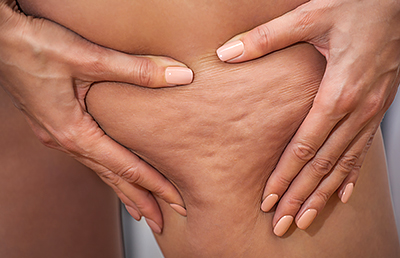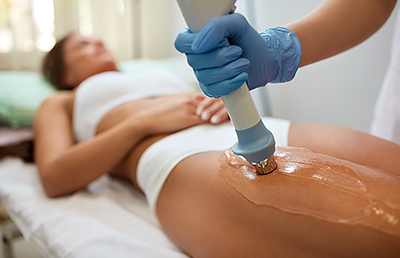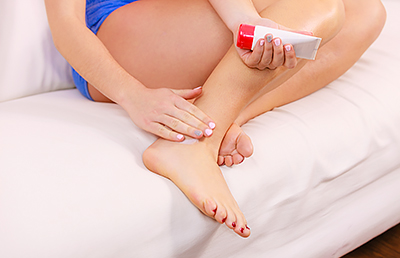Cellulite treatments: What really works?

To find out, dermatologists have been conducting research studies. You’ll be happy to know that the research shows some treatments can make cellulite less noticeable — at least for a while. Here’s the lowdown.
Best results according to research studies
Acoustic wave therapy
Bottom line: Studies show that this can reduce the appearance of cellulite. Several treatment sessions are needed to see a reduction.
Laser treatment
Different types of laser treatments are used to treat cellulite.
During one minimally invasive laser treatment called Cellulaze™, a tiny laser fiber is inserted beneath your skin. When the laser is fired, the laser energy breaks up the tough bands beneath the skin that cause us to see cellulite. This treatment can also thicken your skin, which is important. Skin often thins where cellulite forms. Thickening the skin can help reduce the appearance of cellulite.

Bottom line: Cellulaze™ may reduce the appearance of cellulite. Patients are seeing results that last a year or longer. More research is needed to know for sure how helpful this laser can be.
With other laser treatments, some patients have seen less cellulite. Results can last 6 months or longer; however, a bit of dimpling usually returns.
Subcision
Called Cellfina™, this medical procedure involves your dermatologist inserting a needle just under the skin to break up the tough bands beneath the skin that cause us to see cellulite.
Bottom line: Cellfina™ has been shown to reduce the skin dimpling that you see with cellulite. In a study of 232 patients, 99% of them said they were satisfied with the results. The results can last 2 years and possibly longer.
Vacuum-assisted precise tissue release
This also breaks up the tough bands that cause us to see cellulite. During this procedure, your dermatologist will use a device that contains small blades to cut the tough bands. After the bands are cut, the tissue moves upward to fill out and eliminate the dimpled skin.
Bottom line: This may be an effective treatment for reducing cellulite. A small study shows that many patients who received this treatment had less cellulite for up to 3 years. It’s too soon to tell, but the results may last even longer.
Cellulite is different from fat
Cellulite differs from fat. Treatment that can effectively remove fat often has no effect on cellulite.
Weight loss
Bottom line: Extra weight can make cellulite more visible. For some people, losing weight and staying at a healthy weight reduces the amount of cellulite they see. If you develop loose skin while losing weight, however, cellulite can become more noticeable.
Exercise
Bottom line: Having more muscle makes your skin look smoother and firmer. Replacing fat with muscle can also make cellulite less noticeable.
Evidence the treatment may work
Carboxytherapy
During this medical procedure, carbon dioxide (CO2) gas is inserted just beneath the skin. CO2 differs from carbon monoxide, which can be deadly. Possible side effects from carboxytherapy are discomfort during treatment and temporary bruising.
Bottom line: Early studies show that women may see less cellulite. In one study, 10 women received 8 treatments. After these treatments, the researchers found that the women had a little less cellulite.
Creams and lotions
Bottom line: Researchers have found that some creams and lotions may have an effect on cellulite.

A product that contains 0.3% retinol may also have some effect on cellulite. Some women who’ve used it say they see a little less cellulite. Retinol can help thicken the skin, which may reduce how much cellulite you see. Before you’ll know if retinol can help you, you’ll need to apply the product for 6 months or possibly longer.
If you’re interested in trying a cellulite cream or lotion, it helps to test it on a small area first. Some people have an allergic skin reaction.
Testing on a small area is also important because there have been reports of people becoming anxious or having a racing heart while using a product that contains aminophylline. People who use an asthma inhaler definitely want to avoid using any product that contains aminophylline. Even a cream that contains it can cause breathing problems.
endermologie®
Available at spas, this treatment uses a device that gives you a deep massage while also lifting up your skin with a vacuum-like tool. The U.S. Food and Drug Administration (FDA) approved this as a medical device that has little potential to cause harm. The FDA, however, hasn’t said that it works.
People who offer endermologie® say that a number of treatment sessions are necessary to see results. Each session lasts about 45 minutes.
Bottom line: Study results vary. Some studies found no difference in cellulite between the women who received endermologie® and those who didn’t. Other studies show that the women who received it had a noticeable reduction. These results, however, were temporary.
If you see results, it seems that you must continue the treatments to continue seeing results. The cellulite tends to return within 1 month of stopping treatment.
Ionithermie cellulite reduction treatments
If you opt for this spa treatment, the cellulite will be slathered with algae or clay — and sometimes a mixture of both. Next, electrodes are attached to the area. Before the technician leaves the room, the area will be wrapped in plastic. During the treatment, you’ll feel a mild electric current. Some people say the current feels painful or unpleasant.
This treatment is said to reduce the size of the treated area, which may reduce the appearance of cellulite.
Bottom line: Without independent published studies, it’s hard to know if this works. Some people say their skin feels more toned, but they still see cellulite. Others say they don’t notice any difference. If you see results, they’ll only last about 12 to 18 hours.
Radiofrequency
This is a type of treatment that heats the cellulite. One FDA-approved device combines radiofrequency with a laser, suction, and massage in order to target cellulite.
Bottom line: Recent studies suggest some patients see a little less cellulite. This result, however, is short lived and several treatments are needed to see this minor change.
After treatment, bruises are common. These fade with time.
Too early to tell if these work
Laser-assisted liposuction
Liposuction is an invasive medical procedure that works well for removing small amounts of fat.
Bottom line: While liposuction can remove unwanted fat very effectively, it’s not recommended for getting rid of cellulite. It can make the dimpling more obvious.
Adding a laser treatment to liposuction, however, may help get rid of cellulite. It’s too soon to tell whether laser-assisted liposuction is effective.
Ultrasound
A technique called ultrasonic liposculpting is a non-invasive procedure that targets and destroys fat.
Bottom line: There is no evidence that ultrasound alone can reduce cellulite. When combined with another cellulite treatment, however, ultrasound may reduce the appearance of cellulite. It’s too early to tell whether it will be effective. More studies are needed.
Not recommended for treating cellulite
Cryolipolysis
This treatment freezes unwanted fat to get rid of it.
Bottom line: While it can be very effective for getting rid of small pockets of unwanted fat, it currently cannot get rid of cellulite.
Mesotherapy
During this procedure, you receive a series of injections in the area(s) with cellulite. Different substances are injected into the area, including caffeine, hormones, enzymes, and herbal extracts. Because each practitioner uses a unique blend of ingredients, there’s no way to know what — if any — ingredients are effective.
Bottom line: Few studies show this works. Side effects are common and include redness and swelling, tender lumps beneath the skin, infection, allergic skin reaction, and skin changes.
Supplements
Some people say that taking supplements that contain ingredients like caffeine, grape seed extract, or gingko biloba can reduce cellulite.
Bottom line: There is no evidence that any supplement can reduce cellulite.
A dermatologist can help you decide what’s right for you
Before having any cosmetic (not medically necessary) treatment, it’s always best to consult a doctor who understands and treats the condition. Your results depend on the skill and experience of the person who performs the treatment.
Dermatologists are the skin experts, so they understand the skin and what lies just beneath it. A dermatologist who offers cellulite treatment can help you decide which treatment may be most effective for you and answer your questions.
Related AAD resources
Images
References
Kaminer MS, Coleman WP, et al. “Multicenter pivotal study of vacuum-assisted precise tissue release for the treatment of cellulite.” Dermatol Surg. 2015 Mar;41(3):336-47.
Khan, MH, Victor F, et al. “Treatment of cellulite: Part I. Pathophysiology.” J Am Acad Dermatol. 2010 Mar;62(3):361-70; quiz 371-2.
Khan, MH, Victor F, et al. “Treatment of cellulite: Part II. Advances and controversies.” J Am Acad Dermatol. 2010 Mar;62(3):373-84; quiz 385-6.
Luebberding S, Krueger N, et al. “Cellulite: An evidence-based review.” Am J Clin Dermatol. 2015 Aug;16(4):243-56.
Pianez LR, Custódio FS, et al. “Effectiveness of carboxytherapy in the treatment of cellulite in healthy women: a pilot study.” Clin Cosmet Investig Dermatol. 2016 Aug 22;9:183-90.
 Atopic dermatitis: More FDA-approved treatments
Atopic dermatitis: More FDA-approved treatments
 Biosimilars: 14 FAQs
Biosimilars: 14 FAQs
 How to trim your nails
How to trim your nails
 Relieve uncontrollably itchy skin
Relieve uncontrollably itchy skin
 Fade dark spots
Fade dark spots
 Untreatable razor bumps or acne?
Untreatable razor bumps or acne?
 Tattoo removal
Tattoo removal
 Scar treatment
Scar treatment
 Free materials to help raise skin cancer awareness
Free materials to help raise skin cancer awareness
 Dermatologist-approved lesson plans, activities you can use
Dermatologist-approved lesson plans, activities you can use
 Find a Dermatologist
Find a Dermatologist
 What is a dermatologist?
What is a dermatologist?